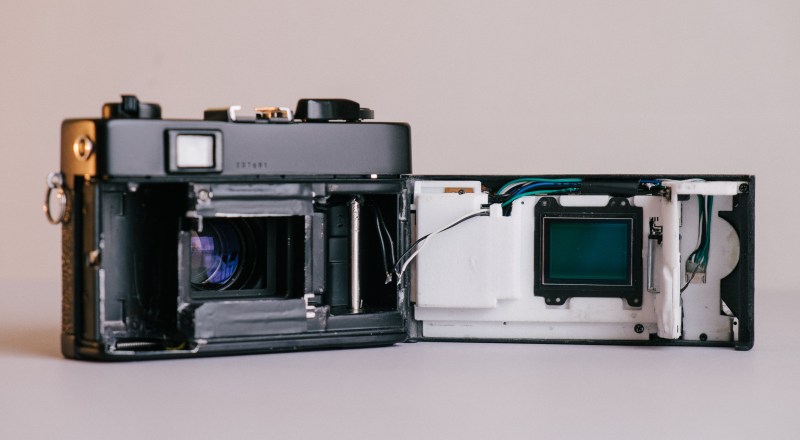After being awarded a generous sum of money from a scholarship fund, [Ollie] decided to utilize some of the cash to convert an analog camera into a device that could store photos onto an SD card. The result was this FrankenCamera that was pieced together from multiple electronic parts to create a new photograph-taking machine.
The Konica Auto S3 rangefinder was chosen due to its stellar fixed 38mm f1.8 lens and unobtrusive internal leaf shutter. A Sony NEX-5 was dismantled and the components were removed and transplanted into the Konica Auto S3. This included a circuit board, SD card slot, and battery connector.
The housing for the electronics was 3D printed from CAD files that were developed in SolidWorks. Designs were sent to a company in London who did the actual SLS printing.
Once completed, the camera operated just like any digital camera, but with the added twist of knowing that it was created from an old school camera frame with new electronic parts, making it a nice hacked together work of functional art.
Videos of the working FrankenCamera can be seen below:
[vimeo http://vimeo.com/105863392%5D
[vimeo http://vimeo.com/104858527%5D
[Thanks for the tip Zac!]
















I really hope this isn’t some sort of elaborate hoax.
Superb job if it isn’t.
I think it is like the guy that stuffed the computer inside a frequency meter.
It requires some craftmanship to turn beautiful, it is interesing to work with the pieces, but it really is just transplanting the insides of one camera to the other. Maybe the phrasing of the article could be different . But it is still an interesting work .
“it really is just transplanting the insides of one camera to the other”
He should call it the frankencamera..
Hi, I’m the guy who made it, I think maybe you have misunderstood, if you read the full article at http://www.frankencamera.wordpress.com you will find that the camera uses the shutter, meter, working viewfinder and lens of the original analog camera and the sensor is the only electronic part. Hope this helps.
Great work! One of the best hacks I’ve seen on this site in a while. My dusty XPan just crawled deeper into the closet :)
good job not researching the name
http://graphics.stanford.edu/projects/camera-2.0/
Rubbish – Frankencamera has been used for decades as a term to describe transplanting bit and pieces from one to another.
Years ago, before DSLRs were a thing, there was an ad for a device shaped like a film roll with the film extended out, that purported to convert your 35mm SLR into a digital camera. Supposedly the device had a CMOS sensor, a small rechargeable battery, a USB charging/data port, and some amount of Flash storage that mounted as a mass storage device. It was ungodly expensive, about $500 if I remember correctly, and I think it ended up being vaporware.
It’s amusing to see the same idea hacked together for a fixed lens camera in 2014.
In the early digital age all big camera manufacturers started by releasing digital backplates for their cameras. Which was helped by the fact that the backs were always made removable anyway.
But of course the resolution and quality of such sensors was not all that stellar.
He made extensive modification to the camera. Any reasonable CMOS sensor is too thick, too large in shape, while imaging area would be too small, and probably hot as hell to fit into an existing camera. “Digital film” concept was to give almost no modifications to cameras, so it’s not exactly a same idea.
“decided to utilize some of the cash to convert an analog camera into a device that could store photos onto an SD card.” So, in other words… the cash was wasted.
and time, basically. ;)
Only time and ebay will tell.
The title makes it sound like he turned an old camera into a film scanner…
Pretty silly to hand-build a digital back, but why not?
http://en.wikipedia.org/wiki/Digital_camera_back
Of course, because why would you want to learn anything when you can just be a consumer and buy it instead. Are you on the right website buddy?
Frankencamera suggests a botched job where you can see the bolt through its neck… this is a work of art… can all of the nae sayers point me to a project of theirs that is even 1/10th as good.
no, frankencamera suggests it has something to do with Stanford project
http://graphics.stanford.edu/papers/fcam/
What to do something really amazing? After decades of successful models, Nikon dropped their entire line of Nikonos amphibious cameras. Convert one of those cameras. Then you will truly have something unique.
Hey, if I could have my Pentax K1000 with a digital insert I’d love it. He created exactly what he wanted, and that’s never a waste.
The next time someone asks me if I believe in intelligent design Ill say, “yes, and here’s an example.” The optics in those old cameras were beautiful. The camera was well selected and great effort in the execution. Well done!
Hi, thanks for all of your kind support! If you are interested I am starting a kickstarter campaign do a reversible digital on a Leica M3,
https://www.kickstarter.com/projects/1807005251/frankencamera-ii
Any help is greatly appreciated,
Ollie